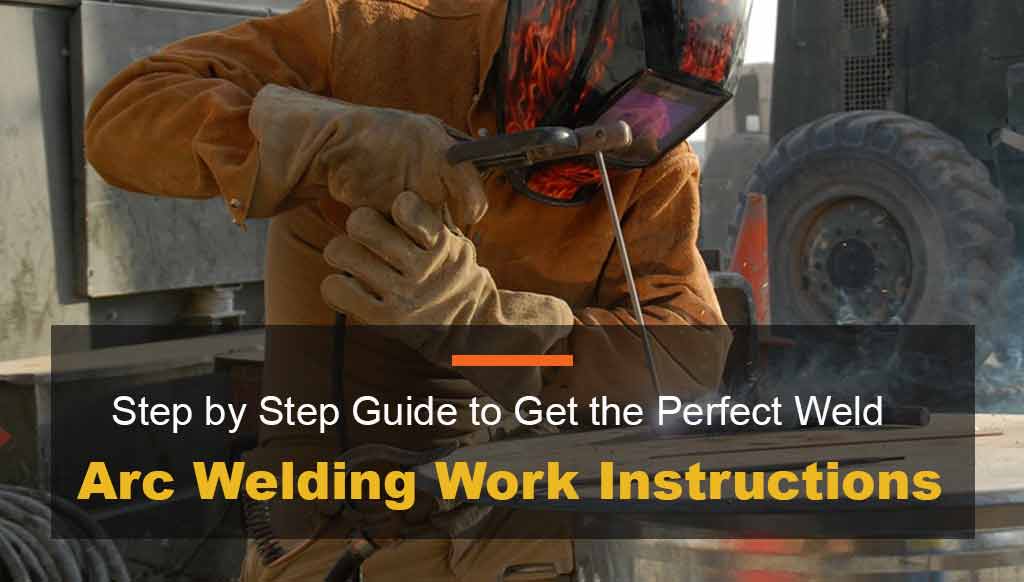
Arc Welding Machine Work Instructions (5 Steps to Improve Your Arc Welding Technique)
An Arc welding machine uses in the fabrication and welding industry. The user is answerable for his and others’ safety. The user should know the threats with the use of this machine and in the industry itself. He needs to follow every instruction provided with the device.
We divide the working of the arc welding machine as follows:
Pre-operation Check for safety
- We should vent the area, open, clean, tidy, safe, and suitable for the welding job. No grease, oils, and other flammable and combustible goods. No other work to avoid electrocution, fumes, noise, flying slags, and radiation in the room.
- Check the machine and cables for cracks and unwind the wires before working.
- Arrange personal protection equipment (PPE) for the operation.
Operational Check for safety
- The arc welder set with the proper current and voltage. The electrode holder and earthing clamp tight. The loose clamp creates a short circuit. The accidental UV welding flash is detrimental to eyes and skin. Erect a UV screen/ curtain at the welding bay.
- The workpiece free from any paint, rust, and oxide layer for better electrical contact.
- Check running welder and its accessories. Never left the welding machine unattended.
- Once welding interrupts or finished, secure the electrode holder, turn off the electric supply.
- Avoid the area until the workpiece gets cool.
Post- Operational Check for safety
- Make sure it switches your welding machine off. The fume extract if used again to stop.
- Hang the electrode holder and earthing clamp at a designated place.
- Contact point checking for any damage/corrosion.
- Clean the work area, welding bench, accessories, and make everything tidy for the next use.
Personal Protection Equipment
- Foot protection by safety shoes.
- Hands protection by hand gloves.
- Eye protection by helmet/goggles.
- Skin protection with welding suit.
- Face protection by face mask.
Potential Hazards
- Welding flashlight injuries to eyes and skin. The helmet, goggles, masks, and proper instructions can reduce this risk.
- Eye injury by hot slags. The appropriate use of glasses and masks in removing the residue is helpful.
- Skin burns are common. The protective clothing, mask, safety shoes help to cut the damage.
- Explosion and fire is a possibility. Keeping the area clean may help to avoid it.
Arc Welding Process
All the arc welding processes need a safe voltage. They need it for arc initiation and maintenance. The melting of the base metal and electrode needs enough amperage. The arc welding process is simple, reliable, and low cost for many years. There are many arc processes in welding and fabrication industries.
The most familiar arc welding processes are:
- MMAW (Manual Metal Arc Welding)
- GMAW (Gas Metal Arc Welding)
- GTAW (Gas Tungsten Arc Welding)
- FCAW (Flux-Cored Arc Welding)
- SAW (Submerged Arc Welding)
Arc Welding Procedure
The welder put on safety shoes, welding suit, gloves, cap, mask, goggles, and helmet. Undertake complete pre welding and welding safety instructions.
Striking An Arc: We bring the electrode in contact with a workpiece of metal. This contact established with tapping action and withdrawal electrode a gap of 1.5 mm to 3.0 mm. This contact generates an arc.
Maintain the Arc: The gap between arc and workpiece, which creates the arc needs to maintain. The persistent, steady movement in one direction of the electrode continues. A constant current passes through the electrode across the arc gap. The current generates heat to melt the electrode and protective flux. The electrode melts over the workpiece under the protective slag from the flux. Remove the residue on the cooling of metal with a chipping hammer or pointed tool.
Stop the Arc: Withdraw the electrode from the metal piece and break the circuit. The electric arc melts the workpiece and electrode at the same time. We thus get a penetration when a molten metal of electrode deposits over the hot metal workpiece. The fusion of electrode metal is complete with the workpiece.
Selection of Electrode: The selection is a very tricky process as there are no fixed criteria for it. It depends upon the welding and thickness of the workpiece.
Warning & Advisory for Arc Welding Process
The user of the arc welding machine should follow the advice in the manual. To make the welding process smooth and safe, we are sharing a few warnings and advisory.
Training of the Operator: The manual of the machine does not cover the process of welding. The person needs the training to operate the welding machine. Qualified or experienced welder of integrity is a choice.
Ventilate the Welding Area: Ventilate the welding area to avoid fumes from flux. The fumes and gases are dangerous for health. An operator can move to on or off the main supply.
Handling the Workpiece: Hold the workpiece with gloves, pliers, and tongs only. It remains hot for quite a long time. It takes time to cools for holding with bare hands.
Fire Risk: It generates fumes, sparks, molten metal droplets, slags, and projectile metals. They can cause a severe fire in the workplace. Avoid any flammable material. Arrange fire extinguishers in the welding area always.
Metal Surfaces for Welding: The surfaces need free from paint, varnish, and coatings. They may emit dangerous fumes. Never weld on pipes and containers filled with flammable gases and liquids.
Extension Cables: Better to avoid the extension leads. In necessity, it should be of suitable rating and have an earth connection. The welding cables should be away from the weld area and hot articles.
Electric Shock Protection: Use a 30 ma residual current device (RCD).
Electrical Insulation: The insulation secure at electrode and accessories. Never touch the welding circuit.
Working Environment: The welding work area should be illuminated and do not weld in rainy or humid places.
Proper Dress: Use a suitable dress and avoid UV light radiates from an arc of the machine. The suite includes a jacket, trousers, gloves, masks, goggles, helmet. A welder is safe from metal projectiles, sparks, and slag.
Isolate Damaged Part: Locate the damaged part. It can affect the functioning and results of welding. Replace or repair immediately.
Safety of Others, Children, and Animals: Clear children, animals from the welding zone. No one has access to the workplace.
Switching Off the Welder: After your work, switch off the welder and disconnect the power supply. Keep the torch, electrode holder, and earthing clamp in place. Take care of the hot workpiece before leaving the machine.
Welding Machine Ventilates: Make sure the ventilation of the welder is on by enough air passage with a fan. It will switch once heated beyond a limit.
Surface Holding Welding Machine: The horizontal surface is ideal for the device. Never put your device on an incline, uneven surfaces, or strap on your back while welding.
Not Working Situation: Change of the Teflon, wire guide and electrode wire roll is not advisable. Never lift the machine when connected to the main supply.
Significant Hazards of Arc Welding Machine
- Electric Shock
- Fumes
- Radiations
- Fire & Explosion
- Burns
1. Electric Shock
The welder may experience convulsions, muscle spasms, and, in rare cases, paralysis or even death. Safety measures eliminate the possibility of electric shock. The welder needs dry gloves, dry safety shoes in good condition, and quality.
Keep the equipment insulated and serviced. Switch off the machine when changing the leads. A rubber mat or wooden is better to avoid electric shock. The sweat of welder is an excellent conductor to electricity. Keep the temperature and ventilation reasonable to prevent perspiration.
2. Fumes
Welder exposes to fumes in arc welding. The fumes are from atmospheric gases, shielding gases, metal vapors, flux gases. The metals like beryllium, cadmium, zinc, lead, and aluminum are dangerous. They are harmful to the liver, kidneys, lungs, blood, and central nervous system. The concentration of the fumes kept in safe limits. The operators can work for a limited period to avoid overexposure.
Clean the welding workpiece from any contaminants. The ventilation is the mainstay to level the fumes at a permissible level. The ventilation is a significant effort for the fumes. The natural ventilation, ceiling exhaust fan, local ventilation requires for it.
3. Radiations
It exposes welder to visible radiation, UV light radiation, infra-red radiation. The visible radiation of high intensity causes a dazzling state. Infrared radiation causes burns and discomfort, and Ultraviolet radiation is exceptionally intense to cause corneal and skin injuries.
The UV light causes inflammation of the cornea called welding flashlight keratitis. Keratitis resolves by itself. It has detrimental effects on the cornea. Personal protection is the answer to the radiation. The welder can use goggles, helmet, gloves, masks, and welding suit to ward off the radiation’s effect.
4. Fire & Explosion
Paper, synthetic materials, oils, paints, wood products, and oils ignite. The spatters, projectile metals, and slag can cause the ignition of the material. Liquid fuel tanks are potential hazards for the explosion in the welder’s vicinity.
Clean and remove any flammable and combustible material from the welding zone. The welder uses proper clothes and arranges fire extinguisher, a handy thing always.
5. Burns
Welding can cause superficial, intermediate, and severe burns depending upon its severity. UV light, infra-red radiation, sparks, slag, heated workpiece, and projectile metals cause injuries.
Use protective articles of clothing, safety shoes, masks, and other protective equipment. Use a tong to hold the hot workpiece and dispose of the hot metal piece to prevent burns.
Arc Welding Machines & Electricity
Every arc welding process requires three segments.
- Power source for the fusion
- Shielding from atmospheric contamination
- Filler material for the weld zone
Welding Current
We need heat for the fusion of the metals from enough amperage. The arc initiation needs a high voltage. Voltage requires to be low enough for the safety of the welder. The welder needs a mean to control current. The supply from the mains is not suitable for welding.
The voltage is very high, and the ampere is low. The main supply from AC transforms for the welding. A dedicated generator or alternator can supply current for the welding.
Types of Current
The Alternating Current and Direct Current are available.
Alternating Current: They take it from the main supply. The current is cyclic. There is a cycle when the current flows from positive to negative. It follows a cycle of current from negative to positive. 50 times the current changes in a second. The cyclic current is even. The alternating current generates heat between the electrode and the workpiece.
Direct Current: The direct current flow in a single direction. The current flow from the negative to the positive pole. It has the most heat at the positive terminal. The best example of DC is a storage battery which has positive and negative terminals.
AC & DC Comparison
Portability: The AC machines are static, transformer-based, and heavy-duty. The DC machines are very portable.
Supply Power: The AC machine restricts near the main power supply while the DC machine runs anywhere.
Polarity: No polarity for AC machine while polarity is the need in DC machines.
Electrical Efficiency: AC machines are 70-90% of electricity efficient. The DC machines are 40-50% only.
Maintenance: AC machines are static and stable and need less support. DC machines are moving from place to place and require more maintenance.
Arc Blow: No effect on AC machines while it is there in DC machines. The arc blow in over 300 amp is tough to control.
Cost of the Establishment: The price in the AC machine is less while the DC machines are expensive to establish.
Cost of Running: AC machines are cheaper to operate as it requires the electric supply. DC machine needs moving the motors and fuel.
Welding Positions
1G – Flat Butt Weld
2G – Horizontal Butt Weld
3G – Vertical Butt Weld
4G – Overhead Butt Weld
5G – Fix Horizontal Pipe Weld
6G – Fix Pipe 45-degree Axis Weld
Here is a link to the various weld symbols.
Arc/Stick Welding (MMAW)
A low voltage and high current produce an arc between the tip of the electrode and the workpiece. It generates heat to melt the workpiece and tip of the electrode. The covering of the electrode melts with the heat. The flux on melting creates a shielding area which protects the weld pool from atmospheric contamination and oxidation.
The electrode melts to the droplets. The droplets of metal add to the molten parent metal. The welding zone gets cool to create a secure joint covered with slag. Now remove the slag with a chipping hammer.
Arc welding uses structural, pressure vessel, fabrication, construction site, piping maintenance, general fabrication. It is a low cost, reliable, simple, versatile, low maintenance, and a wide range of applications.
The welding process has a low operator duty cycle and lower deposition. The time requires changing; the electrode wasted. This process is not fit for a high production application. There are slag inclusion, porosity, fusion deficiency, undercut, stray arc, and excessive spatters.
MIG Welding (GMAW)
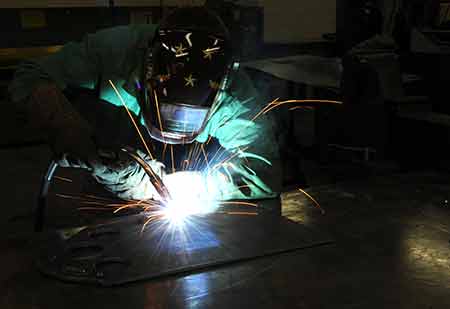
The MIG welding process is suitable for the high production fabrication of metal sheets. Mig welding requires electricity to generate heat, filling materials, and shielding gas, and the operator holds the gun trigger and charges the electrode.
The wire feeder continues to feed the electrode. Shield gas is passing through the gun. The touching of the electrode with metal starts the arc. The arc produces heat to melt the electrode and base metal. The shielding gas prevents oxidation from air impurities.
The Mig welding process is a choice in high production fabrication. In the selected situation of Mig welding, a robot uses. Mig welding is a choice for carbon steel, stainless steel, and aluminum. The aluminum welding requires changes in the wire feeder and gun. The very soft metal is aluminum.
TIG Welding (GTAW)
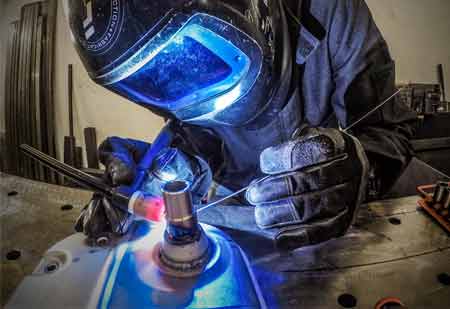
Tig welding needs heat, filler material, and shielding gas. The heat gains from the welding arc. The arc results from contact of tungsten with the metal at the passage of electric current. The triggering of Tig gun supplies the shielding gas to protect the weld zone. It is a technique that requires more practice.
One-hand keeps the continuous torch movements, and the other hand supplies the filler material. This heat melts the filler material and base metal. The molten filler precipitates on the heated base metal. The cooling welding zone can establish a long-lasting and beautiful connection.
Tungsten inert gas (TIG) uses a non-consumable electrode. It is a choice of welding for thin stainless steel sheets and welding processes for non-ferrous materials such as magnesium, aluminum, and copper alloys.
Flux-Cored Arc Welding (FCAW)
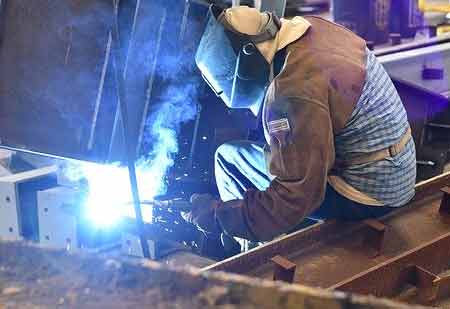
FCAW, a semiautomatic process, is an arc welding process like Mig welding in many aspects. The equipment is the same in principle. The filler material here is hollow. The hollow has flux material. This flux helps in the prevention of oxidation at the weld pool.
The process is useful in shipbuilding, pipeline welding, underwater welding, repair, and maintenance. It is a quicker and versatile process, and No need to carry the gas cylinder here. It has an inbuilt shielding facility.
Submerged Arc Welding (SAW)
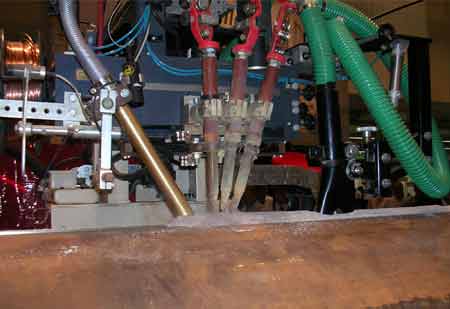
SAW is an arc welding process. An arc forms between the moving electrode and the workpiece.
We use flux as a shield of protection.
The flux avoids oxidation and acts as a slag to protect the weld zone.
This versatile process of welding uses for longitudinal and circumferential butt welding. This process is suitable for pressure vessels and pipeline welding.
FAQs: About Best Welding Machine Brand in India
Which type of welding is best?
Mig is the most versatile and adaptable method of welding and is the best method to learn by a beginner.
What is the most common welding process?
Metal inert gas is the most common welding process in fabrication.
What are the five basic joints?
The five basic joints in welding are the butt joint, the lap joint, the tee joint, the corner joint, and the edge joint.
Which welding process is the strongest?
The stick or arc welding is the strongest welding.
Which welding process is precise?
The Tig welding process is most precise.
What is the hardest type of welding?
Tig welding is the hardest type of welding.
Do welders get cancer?
The persistent long exposure to welding fumes causes cancer.
Why do welds fail?
The lack of training and improper choice of welding machine leads to failure of the welding.
How hot is Tig arc?
The Tig arc is of 11000-degree Fahrenheit.
Why do welders drink milk?
The zinc emits from galvanized steel. The calcium of milk helps the welder. The welder saves from zinc toxicity.
